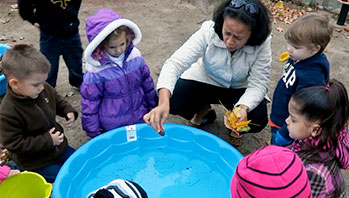- bag
- camera or cell phone with camera
- clipboards
- markers or crayons
- paper
- small objects (balls, blocks, eraser, etc.)
- wooden block
- inclined plane
- move
- ramp
- slant
- slide
- slope
- steep
MA Standards:
English Language Arts/Language/L.PK.MA.6: Use words and phrases acquired through conversations, listening to books read aloud, activities, and play.
MA Draft Standards:
Physical Sciences/Motion and Stability; Forces and Interaction/PS2.A: Plan and carry out investigations of the behaviors of moving things.
Physical Sciences/Motion and Stability; Forces and Interaction /PS2.B: Using evidence, discuss ideas about what is making something move the way it does and how some movements can be controlled. [Cause and Effect, Stability and Change]
Head Start Outcomes:
Logic and Reasoning/Reasoning and Problem Solving: Recognizes cause and effect relationships.
Science Knowledge/Scientific Skills and Method: Uses senses and tools, including technology, to gather information, investigate materials, and observe processes and relationships.
PreK Learning Guidelines:
English Language Arts/Language 2: Participate actively in discussions, listen to the ideas of others, and ask and answer relevant questions.
Explore Together (outdoors): Hunt for Slides, Ramps, and Tracks

© Commonwealth of Massachusetts, Department of Early Education and Care. All rights reserved.
STEM Key Concepts: A ramp, or inclined plane, is a surface with one end higher than the other; An object placed on an inclined plane will roll, slide, or stay put
ELA Focus Skills: Speaking and Listening, Vocabulary
Tell children you are going to take them outdoors again to look for slides, ramps, and tracks. Explain that they will explore and draw or write to record what they observe about ramps. Explain that you will:
- Bring a bag of objects so children can continue to explore how objects move down ramps, slides, and tracks
- Allow time for them draw or dictate their ramp observations before they return inside.
Take children to an location outside where they are likely to see a variety of ramps (buildings with ramps; roofs on houses; crosswalks with inclines; hills; park area with slides, seesaws, construction site with track ramps, delivery trucks with ramps, etc.) Allow plenty of time for children to explore safely.
- Take photos or encourage children to take photos to document explorations
- Encourage them to document how things move down different surfaces, such as sloped walkways, grassy or not-so-grassy hills, access ramps to buildings, delivery trucks with ramps, strollers, etc.
- Have children compare how things move down different concrete areas with the block. Talk about why it does or doesn’t slide (steepness of ramp, texture, shape of block).
- Let children place a ball on a grassy or dirt incline to see if it rolls. Talk about what happens.
Reflect and Share Together
Once inside, talk about the explorations and discoveries children made. Have children share the photos and their drawings and what they were observing at the time they took the photo/drew the picture.
- You may want to have children turn to a buddy and discuss ane compare their observations.
